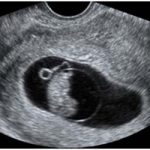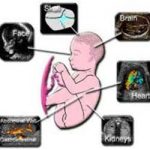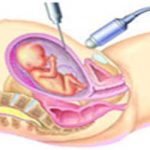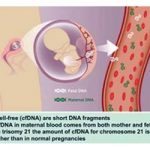Down’s syndrome screening during Pregnancy
What is Down’s syndrome?
 In 1866 an English doctor, John Langdon Down, described a group of people who shared a consistent pattern of characteristics and this condition was named after him.
In 1866 an English doctor, John Langdon Down, described a group of people who shared a consistent pattern of characteristics and this condition was named after him.
Down’s syndrome is a genetic condition that results in learning disability and range of physical charecteristics.Down’s syndrome is the most common inherited cause of learning disability in children. This can vary from mild to severe and the majority need long term help and support.
People with Down’s syndrome tend to look different – they typically have a flat facial profile and eyes that slant upwards, smaller ears etc. They are shorter than average with poor muscle tone and have short, broad hands with a single crease across the palm. They can have number of health problems such as heart problem, digestive system problem, reduced hearing,vision etc.
How common it is?What are the risk factors?
Anyone can have a baby with Down’s syndrome regardless of age, family history or ethnic background. It does not usually run in families. Overall the incidence is 1 in every 800 pregnancies.
However, the chance of having a baby with Down’s syndrome increases with the age of the mother, especially over the age of 35. Most cases are sporadic (the parents aren’t affected) and the risk of recurrence in further pregnancies is very small.
Maternal age: The likelihood of having a baby born with Down’s syndrome increases with the mother’s age:
✓ 20 years – 1 in 1,500
✓ 25 years – 1 in 1,300
✓ 30 years – 1 in 900
✓ 35 years – 1 in 350
✓ 40 years – 1 in 100
✓ 45 years – 1 in 30
What causes Down’s syndrome?

The human body is made up of cells. Each cell works like a factory and essential for growth and maintenance of our body. Every cell contains nucleus in which genes are stored. The genes control the work of the cells and they are grouped in a rod like structures called chromosomes.Usually, the nucleus of the each cell contains 23 pairs of chromosomes.23 are inherited from the mother and 23 from the father and this makes 46 in total.
In people with Down’s syndrome, all or some of the cell bodies contains 47 chromosomes, as there is extra copy of chromosome 21(therefore this condition is also known as trisomy 21).This extra genetic material results in range of physical and developmental problems.
Can we cure Down’s syndrome?

Unfortunately the extra chromosome cannot be removed from the cells and hence there is no cure for this condition. But treatment of any accompanying health problems and support for learning difficulties allow many people with the syndrome to lead relatively normal and semi-independent lives. Others, however, need full-time care. Many people with the condition live well into adulthood, with an average life expectancy of around 60 years. Physiotherapy, speech therapy and special educational programmes have an important role to play. But the most important aspect is support from family and society.
How are the Down’s syndrome screening tests done during pregnancy? And what is the sensitivity?

✓ Ultrasound scan is carried in between 11 weeks to 13 weeks 6 days of pregnancy.
To measure the neck fold thickness of the baby (in babies with Down’s syndrome usually this value is increased). New ultrasound markers such as nasal bone, blood flow through heart and liver are also studied in high risk cases.This test (along with age of patient) has the detection rate of Down’s syndrome up to 80%.
✓ Blood sample from the mother is taken to test for two pregnancy hormonescalled PAPP-A and ß HCG
Combination of 1&2 with other details of mother such as age, weight, pregnancy details – is called Combined Screening. This test has detection rate of 90-95%. This test also detects other chromosomal problems pregnancy. To use the software for the risk calculation-the clinician performing scan should be certified from Foetal medicine foundation UK.
When will be the result is available?
The only ultrasound risk calculation result on the same day and the combined screening result will be available usually within 3 working days.
What happens if the pregnant lady is late for combined screening?
If pregnancy duration is more than 13 weeks 6 days then the only option would be the blood test (Triple test or most resent one quadruple test).This is done from 15 weeks to 20 weeks 6 days. The detection rate is only 60 -65%.
What are the advantages of combined screening over Triple test?
Apart from very high detection rate, the combined screening will identify problems very early on pregnancy hence the couple can take appropriate decision. If the blood tests done for the combined screening is abnormal and if baby does not have chromosome problem then,this could also indicate deficiency in the placenta and this can lead to growth restriction of the foetus, high blood pressure in mother and hence closer surveillance of these pregnancies is recommended.
What does screen positive result mean?
The estimate of the risk will be mentioned as a ratio e.g.: risk of 1 in 100 which means only one in 100 women will have a Down’s syndrome baby. The cut off above which mother is called as high risk is 1 in 150.The test has false positive rate of around 5% (i.e. test result wrongly show as positive).
Does the screening test detect all pregnancies with Down’s syndrome?
No, as this is a screening test and not a diagnostic test.The combined screening will detect 9 out of 10 cases (classified as screen positive) and the triple test will detect 6 out of 10 cases.
What are the diagnostic tests for Down’s syndrome or other chromosomal problems?
If the result is screen positive or sometimes if mother’s age is more than 35, then diagnostic tests in the form of CVS (Chorionic villous samplings) or Amniocentesis is offered to check the chromosomes of the baby.There is a small risk of miscarriage (about 1 in 100) as a result of the procedure.
Will the diagnostic tests guarantee that baby is free of all birth defects?
No test can guarantee that the baby will be free of all birth defects. But if the result of CVS or amniocentesis is negative it will almost certainly rule out Down’s syndrome and other major chromosomal abnormalities.
What if the diagnostic test confirms Down’s syndrome?
The options are either to terminate to pregnancy or to accept this and continue the pregnancy. However it is important to understand the need for the lifelong support for Down’s syndrome baby.
Are there any alternatives (without having diagnostic test) if the risk is high after screening test?
A detailed targeted anomaly scan around 18-20 weeks can be performed and if this is normal then the risk is reduced by another 50%.This means if the initial risk is 1 in 100 now the risk is further reduced to 1 in 200. However, normal scan cannot exclude Down’s syndrome because 50% cases of the Down’s babies will not have any structural abnormalities. It is therefore important to understand that the only way to rule out chromosomal abnormality is by doing diagnostic test.
Would it be possible to test for the baby’s chromosomes from the mother’s blood sample?
Small amount of foetal DNAs are passed on to mother’s blood and therefore it would be possible to study foetal chromosomes and few foetal genetic problems from mother’s blood sample. However, an extensive research is on in this field regarding accuracy of such testing and hence at present this is not done routinely.









